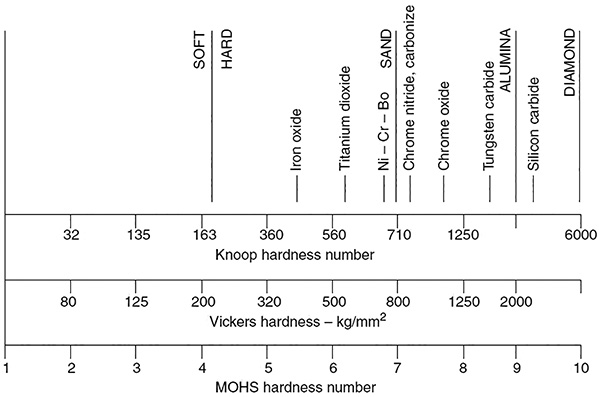Q. Can rotary type pumps be used to pump slurries? If so, should users be aware of any special precautions?
A. Rotary pumps may be used to transfer slurries when the application dictates. Hard-particle slurries can cause abrasive wear to efficiency-critical components in rotary pumps, which reduces volumetric and mechanical efficiency. Users must carefully select and apply rotary-type pumps in slurry service.
The concentration of solids usually has the greatest effect on fluid characteristics of the mixture. A fluid containing only a trace to 3 percent by weight of fine sand content in crude oil, for example, would not be considered a slurry. A range of 5 to 15 percent by weight slurry of paper stock, however, goes through three stages of fluidity or shear characteristics, while high concentrations of finer solids can change watery carrier liquid to viscous—even thixotropic—fluid.
The size and shape of the solids in a slurry normally determine whether a particular rotary pump configuration and/or cavity, or chamber size, can be used for the slurry in question. Typically, the cavity must be greater than particle size.
In some pumps, the rotor configuration will accept larger particles as long as the size, distribution and shape are controlled. The size must be related to porting, rotor cavity size, configuration and interaction, and operating clearance.
The hardness of solids greatly influences the wear rate of the rotary pump because of close relative motion of surfaces at the rotor tip or flank. The range of hardness is from soft solids, such as polymer chains of lubricating quality, to fibrous products that are usually soft but may carry hard particles, to very hard, irregular particles such as sand and carbon. Carbon is primarily soft, but the aggregate carries lumps with hardness approaching that of silicon carbide. A qualitative scale listing the hardness of several materials is often useful to compare solids and select pump materials (see Figure 3.3.16.1.4).
 Figure 3.3.16.1.4. Materials hardness (Courtesy of Hydraulic Institute)
Figure 3.3.16.1.4. Materials hardness (Courtesy of Hydraulic Institute)Critical factors governing a system handling a watery slurry, in which the solids have a much higher specific gravity than the carrier liquid, are the settling rate and characteristics. The settling rate measures how quickly solids will fall out of suspension in a slurry.
Coarse solids with high settling rates that are carried in a rotary pump require precautions to prevent bridging, draining and squeeze-out.
Because speed directly affects product shear and the relative velocity of solids to the housing and rotor, pump speeds should always be reduced well below those for nonabrasive fluid applications, regardless of the type of rotary pump used for abrasive slurries.
For more information on this subject, see the Hydraulic Institute Standard ANSI/HI 3.1-3.5
Rotary Pumps for Nomenclature, Definitions, Application and Operation.
Q. How is the performance of air-operated diaphragm pumps affected by the viscosity and specific gravity of the liquid?
A. A pump manufacturer's published data is normally based on testing with water. The supplied air pressure, pump flow rate, net positive inlet pressure (NPIP)/net positive suction head (NPSH) and the pumping system determine the discharge pressure for a given air-operated diaphragm/bellows pump.
Liquids with viscosity below 500 centipoise do not usually affect manufacturers' published pump performance data. As viscosity increases above this value, the possibility of liquid cavitation increases, and drops in pressure across pump components—particularly the suction check valves—raise the required NPIP/NPSH significantly.
Specific gravity can also affect pump suction performance. A liquid with a high specific gravity will reduce the manufacturer's published data on suction-lift capabilities.
Viscous liquids tend to impede efficient check valve operation, which can result in a reduced flow rate. This condition is caused by delayed check valve seating and reverse liquid flow.
End users should carefully determine the nature of the liquid being pumped. Non-Newtonian or shear-sensitive liquids may have pumping characteristics unrelated to those of Newtonian liquids with similar quiescent viscosity. Apparent viscosity for an application using a non-Newtonian liquid can be adjusted based on flow rate conditions for the application by consulting the material manufacturer's shear rate versus shear stress diagram for the specific material.
For more information on air-operated pumps, see the Hydraulic Institute Standard ANSI/HI 10.1-10.5
Air-Operated Pumps for Nomenclature, Definitions, Application and Operation .
Q. Can I use the same type of variable frequency drive (VFD) for a rotodynamic pump and a positive displacement pump?
A.Rotodynamic pumps and positive displacement pumps have different torque characteristics as speed is varied. The VFD selected must supply sufficient current to the motor so the motor can produce the required torque throughout its operating range.
With a variable torque load, the torque loading is a function of speed. This type of load requires less torque at lower speeds than constant torque loads. Rotodynamic pumps, fans and certain blowers (consult the blower manufacturer) are common applications that have a variable torque load. As the speed decreases, the torque decreases with the square of the speed, and the power decreases by the cube of the speed.
When selecting a VFD for a rotodynamic pump application, many manufacturers recommend a variable torque or standard-duty-rated VFD. This labeling is commonly referenced for the overload capacity of the drive. As always, discuss the application, installation and its nuances with the drive representative, as the installation or application may require a drive outside the typical one utilized in variable torque service.
With a constant torque application, the torque is not dependent on speed. Constant torque applications include positive displacement pumps, conveyors, belt presses, screws and augers. Although the torque remains constant as the speed increases, the power changes linearly with speed.
When selecting a VFD for a constant torque application, VFD manufacturers will recommend a drive specific to that application. Contact your drive representative with the specifics of your constant torque application.
For more information on variable frequency drives, see the Hydraulic Institute Guidebook
Variable Frequency Drives: Guidelines for Application, Installation and Troubleshooting.


